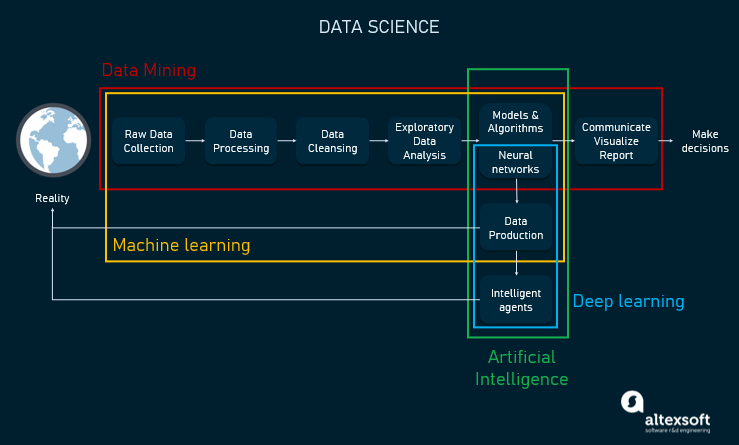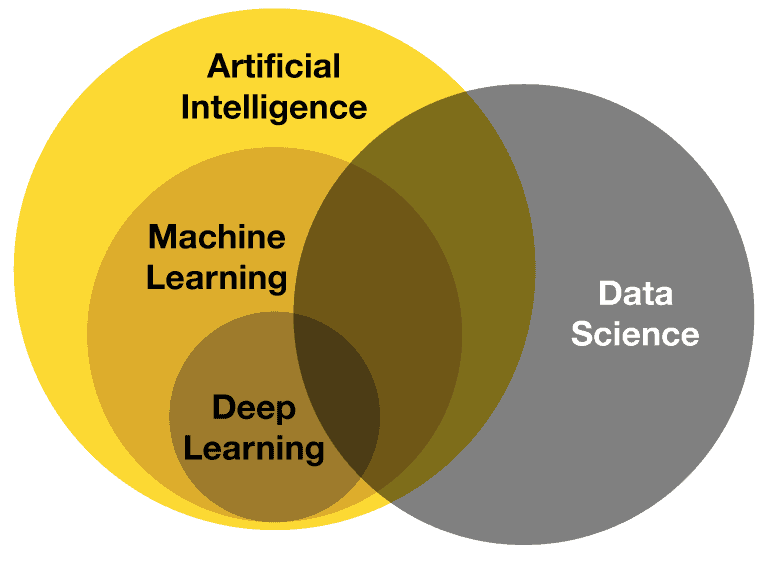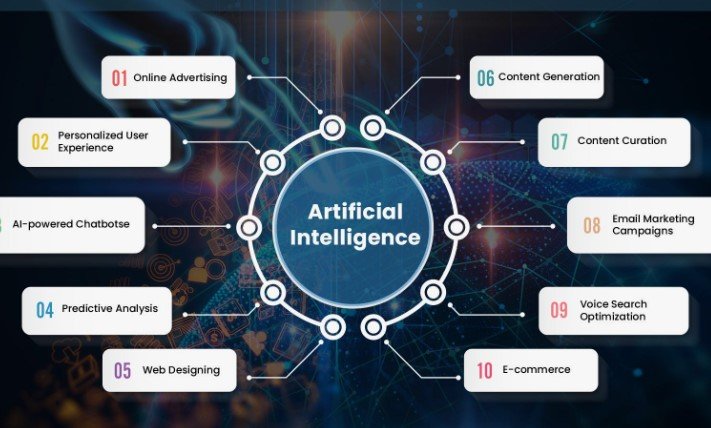Data Science, Machine Learning, and Artificial Intelligence (AI) are three distinct but related fields in the tech industry. Data science involves forecasting future trends, AI anticipates user preferences and behavior, and machine learning enables algorithms to make informed guesses based on patterns they’ve discerned.
These fields have seen tremendous growth in recent years, and their applications span across various industries, including healthcare, finance, and e-commerce. Understanding the differences between Data Science, Machine Learning, and AI is crucial in choosing the right career path or adopting the right technology for a particular business problem.
We will explore the definitions, differences, and applications of Data Science, Machine Learning, and Artificial Intelligence.
Table of Contents
Data Science Machine Learning Artificial Intelligence

What Is Data Science?
Data Science, Machine Learning, and Artificial Intelligence are integral fields in the realm of technology. Each plays a crucial role in extracting insights, making predictions, and automating processes. In this blog post, we will delve into the definition of Data Science, its importance, and its various applications.
Definition Of Data Science
Data Science encompasses the extraction of meaningful insights from structured and unstructured data through various methods such as statistics, machine learning, and data analysis. It involves utilizing algorithms, scientific methods, and systems to uncover patterns, trends, and correlations within large datasets. The primary goal of Data Science is to extract valuable knowledge and insights from data to aid in decision-making processes.
Importance Of Data Science
The importance of Data Science lies in its ability to drive informed decision-making, improve operational efficiency, and enhance business strategies. By leveraging Data Science, organizations can gain a competitive edge by identifying market trends, predicting customer behavior, and optimizing processes. Furthermore, it enables the development of personalized user experiences, targeted marketing campaigns, and innovative product offerings, thereby fostering growth and sustainability.
Applications Of Data Science
Data Science finds applications across various industries, including but not limited to:
- Finance: Risk assessment, fraud detection, and algorithmic trading
- Healthcare: Disease prediction, personalized medicine, and medical image analysis
- Marketing: Customer segmentation, recommendation systems, and sentiment analysis
- Transportation: Route optimization, demand forecasting, and predictive maintenance
Introduction To Machine Learning
Introduction paragraph about Data Science and Learning Artificial Intelligence and Introduction to Machine Learning…
Definition Of Machine Learning
Machine Learning is a subset of artificial intelligence that enables systems to learn and improve from experience without being explicitly programmed. It focuses on the development of computer programs that can access data and use it to learn for themselves.
Types Of Machine Learning
There are primarily three types of Machine Learning algorithms: Supervised Learning, Unsupervised Learning, and Reinforcement Learning. Supervised learning involves training a model on a labeled dataset, unsupervised learning deals with unlabeled data, and reinforcement learning uses a reward-based system for decision-making.
Applications Of Machine Learning
Machine Learning finds applications in various fields, such as healthcare for disease prediction, finance for fraud detection, marketing for personalized recommendations, autonomous vehicles for decision-making, and natural language processing for sentiment analysis.
Artificial Intelligence And Its Types
Data Science, Machine Learning, and Artificial Intelligence are rapidly evolving fields that have gained significant attention in recent years. In this blog post, we will focus on Artificial Intelligence and its types, aiming to provide a comprehensive understanding of the subject.
Definition Of Artificial Intelligence
Artificial Intelligence, commonly referred to as AI, encompasses the development of intelligent machines that can perform tasks that typically require human intelligence. This includes learning, problem-solving, and decision-making. AI systems are designed to analyze their environment and take action to achieve specific goals.
Types Of Artificial Intelligence
Artificial Intelligence can be classified into two main types: Narrow AI and General AI. Narrow AI, also known as Weak AI, is designed to perform a specific task, such as speech recognition or language translation. On the other hand, General AI, also known as Strong AI, possesses the ability to understand, learn, and apply knowledge across various domains, similar to human intelligence.
Applications Of Artificial Intelligence
The applications of Artificial Intelligence are vast and diverse. AI is extensively used in healthcare for disease diagnosis and personalized treatment recommendations. In finance, AI is utilized for fraud detection and risk assessment. Additionally, AI is employed in autonomous vehicles, customer service, manufacturing, and entertainment, among other sectors.
Data Science Workflow
Data Science and Machine Learning Artificial Intelligence is a rapidly growing field that combines statistical analysis, machine learning algorithms, and artificial intelligence techniques to extract valuable insights from large datasets. In this blog post, we will explore the data science workflow, which is the process of collecting, cleaning, analyzing, and visualizing data to derive meaningful conclusions and make informed decisions.
Data Collection
Data collection is the first step in the data science workflow. It involves gathering relevant data from various sources, such as databases, APIs, web scraping, or manual entry. The collected data can be structured or unstructured and may include text, images, videos, or numerical values. It is important to ensure the data collected is accurate, complete, and representative of the problem at hand. Data collection methods may vary depending on the specific project requirements.
Data Cleaning
Data cleaning is the process of removing errors, inconsistencies, and inaccuracies from the collected data. This step is crucial to ensuring the quality and reliability of the data for analysis. Common data cleaning tasks include handling missing values, removing duplicates, correcting typos, standardizing formats, and dealing with outliers. Various tools and techniques, such as data wrangling libraries, statistical methods, and data visualization, can be used to clean and preprocess the data.
Data Analysis
Data analysis involves exploring and examining the cleaned data to uncover patterns, trends, and relationships. This step includes applying statistical methods, machine learning algorithms, and data mining techniques to gain insights and make predictions. Data analysis can be performed using programming languages like Python or R, along with specialized libraries and tools. It helps in understanding the underlying patterns and factors that drive the data and enables data-driven decision-making.
Data Visualization
Data visualization is the process of representing the analyzed data visually through charts, graphs, and interactive dashboards. It helps in effectively communicating complex information, making it easier to understand and interpret. Data visualization techniques can be used to identify patterns, trends, and outliers, as well as to present the results of data analysis. Visualizing the data allows stakeholders to gain meaningful insights and make informed decisions based on the information presented.
Machine Learning Algorithms

Data Science and Machine Learning Artificial Intelligence is a field that encompasses the study of algorithms and statistical models to enable computer systems to learn and make predictions or decisions without explicit programming. Machine Learning Algorithms are a crucial component of this field, as they provide the foundation for training and predicting outcomes based on data. In this blog post, we will explore three types of machine learning algorithms: Supervised Learning, Unsupervised Learning, and Reinforcement Learning.
Supervised Learning
Supervised Learning is a machine learning algorithm that involves training a model on labeled data. The model learns from the input-output pairs and uses this knowledge to predict the output for new, unseen inputs. Some common supervised learning algorithms include:
- Linear Regression
- Logistic Regression
- Decision Trees
- Random Forests
- Support Vector Machines
- Naive Bayes
Supervised Learning is widely used in applications such as spam detection, sentiment analysis, and image recognition. It is characterized by the presence of a target variable that the model aims to predict. The model is trained using a labeled dataset where each data point is associated with a known output value. The goal of supervised learning is to find the best function that maps the input variables to the output variable.
Unsupervised Learning
Unsupervised Learning is a machine learning algorithm that deals with unlabeled data. The goal of unsupervised learning is to find patterns or groupings in the data without any prior knowledge of the output. Some common unsupervised learning algorithms include:
- K-means Clustering
- Hierarchical Clustering
- Principal Component Analysis (PCA)
- Association Rule Learning
- Self-Organizing Maps (SOM)
Unsupervised Learning is used in various applications such as customer segmentation, anomaly detection, and recommender systems. It helps in discovering hidden structures or relationships in the data. Unlike supervised learning, unsupervised learning does not require labeled data and focuses on finding the underlying patterns or structure in the dataset.
Reinforcement Learning
Reinforcement Learning is a machine learning algorithm that involves an agent interacting with an environment to learn a series of actions that maximize a reward. The agent learns by trial and error, receiving feedback in the form of rewards or penalties based on its actions. Some common reinforcement learning algorithms include:
- Q-Learning
- Deep Q-Networks (DQN)
- Policy Gradient
- Actor-Critic
Reinforcement Learning is used in applications such as game playing, robotics, and autonomous driving. It enables the agent to learn optimal strategies or policies through exploration and exploitation of the environment. The agent learns to take actions that lead to maximum rewards and avoids actions that result in penalties or undesired outcomes.

Artificial Intelligence Techniques
Data Science and Machine Learning Artificial Intelligence (AI) is a rapidly growing field that has been transforming several industries. AI is a branch of computer science that focuses on creating machines that can perform tasks that would normally require human intelligence. In this blog post, we will be discussing the various Artificial Intelligence techniques, including Natural Language Processing, Computer Vision, and Robotics.
Natural Language Processing
Natural Language Processing (NLP) is a subfield of AI that focuses on enabling machines to understand human language. NLP is used in several applications, such as chatbots, speech recognition systems, and language translation tools. Some of the common techniques used in NLP include:
- Sentiment Analysis
- Named Entity Recognition
- Part-of-Speech Tagging
Computer Vision
Computer Vision is a subfield of AI that focuses on enabling machines to interpret and understand visual information from the world around us. Computer Vision is used in several applications, such as self-driving cars, facial recognition systems, and object detection tools. Some of the common techniques used in Computer Vision include:
| Technique | Description |
|---|---|
| Object Detection | Identifying objects within an image or video |
| Image Segmentation | Dividing an image into segments for easier analysis |
| Optical Character Recognition | Converting images of text into machine-readable text |
Robotics
Robotics is a subfield of AI that focuses on creating intelligent machines that can perform tasks autonomously. Robotics is used in several applications, such as manufacturing, healthcare, and space exploration. Some of the common techniques used in Robotics include:
- Simultaneous Localization and Mapping
- Path Planning
- Control Systems
Real-world Applications Of Data Science, Machine Learning And Artificial Intelligence
Data Science, Machine Learning, and Artificial Intelligence are revolutionizing various industries and have real-world applications in healthcare, finance, retail, transportation, and entertainment.
Healthcare
Data science, machine learning, and artificial intelligence play a crucial role in healthcare. They enable predictive analytics for patient diagnosis and treatment, personalized medicine based on genetic data, and improving operational efficiency through predictive maintenance of medical equipment. Additionally, these technologies aid in drug discovery and development by analyzing large datasets, leading to more effective pharmaceuticals and treatments.
Finance
In the finance sector, data science, machine learning, and artificial intelligence are utilized for fraud detection and prevention, risk assessment and management, algorithmic trading, and customer relationship management through personalized financial services. These technologies also assist in automating processes such as underwriting, claims processing, and regulatory compliance, improving the overall efficiency of financial institutions.
Retail
Data science, machine learning, and artificial intelligence have transformed the retail industry by enabling personalized recommendations for customers, inventory optimization through demand forecasting, dynamic pricing based on market trends, and customer sentiment analysis to enhance marketing strategies. These technologies also facilitate supply chain optimization and predictive maintenance for retail infrastructure.
Transportation

In transportation, data science, machine learning, and artificial intelligence are applied for route optimization, predictive maintenance of vehicles and infrastructure, autonomous vehicle development, and transportation network modeling. These technologies also contribute to traffic management and real-time predictive analytics, which improve overall transportation efficiency.
Entertainment
The entertainment industry leverages data science, machine learning, and artificial intelligence for content recommendation, personalized user experiences, audience segmentation, and predictive analytics for content creation. These technologies also aid in content moderation and copyright infringement detection to ensure a safe and legal digital environment for users.
Future Of Data Science, Machine Learning, And Artificial Intelligence
Data Science, Machine Learning, and Artificial Intelligence are revolutionizing industries and shaping the future. From predicting trends to understanding user behavior, these technologies play a crucial role in driving innovation and progress.
Challenges And Opportunities
Challenges: Implementing complex algorithms efficiently can be challenging. Data privacy and security issues are major concerns.
Opportunities: Data-driven decision-making offers businesses a competitive edge. AI automation can streamline processes and boost productivity.
Emerging Trends
AI-Powered Personalization: Customized user experiences through AI algorithms are gaining popularity.
Edge Computing: Processing data closer to the source for faster insights and reduced latency.
Explainable AI: Transparent AI models that provide insights into decision-making processes.
Impact On Society
Job Transformation: Automation may lead to job displacement but also create new opportunities in tech-related fields.
Ethical Considerations: Ensuring AI algorithms are unbiased and ethical to prevent discrimination.
Conclusion
In the ever-evolving world of technology, the fields of data science, machine learning, and artificial intelligence have become essential for businesses and industries. Data science enables us to forecast future trends, while artificial intelligence anticipates user preferences. Machine learning, on the other hand, empowers algorithms to make informed guesses based on patterns they’ve recognized.
Whether you’re analyzing data for insights or developing systems that mimic human behavior, these disciplines offer unique opportunities for growth and innovation. By harnessing the power of data, we can unlock new possibilities and drive progress in the digital age.

